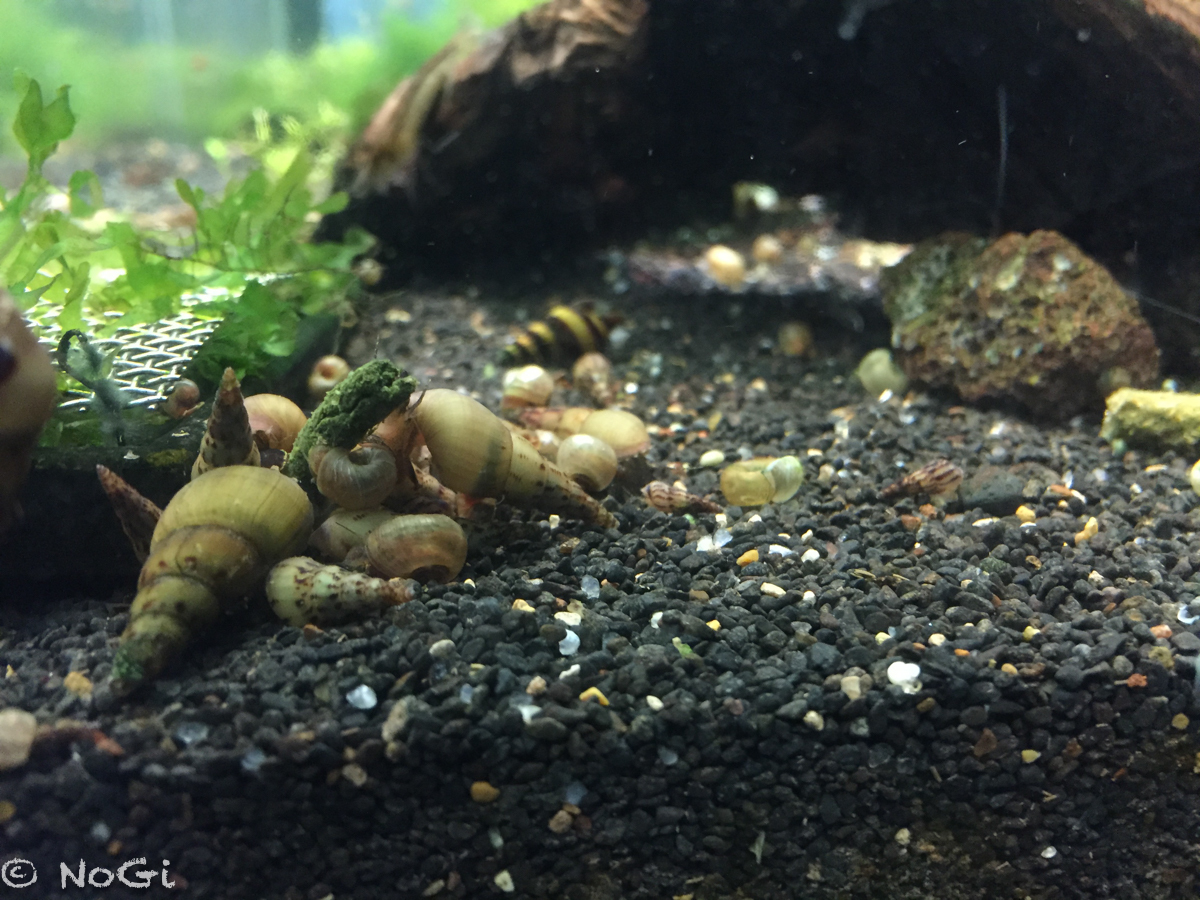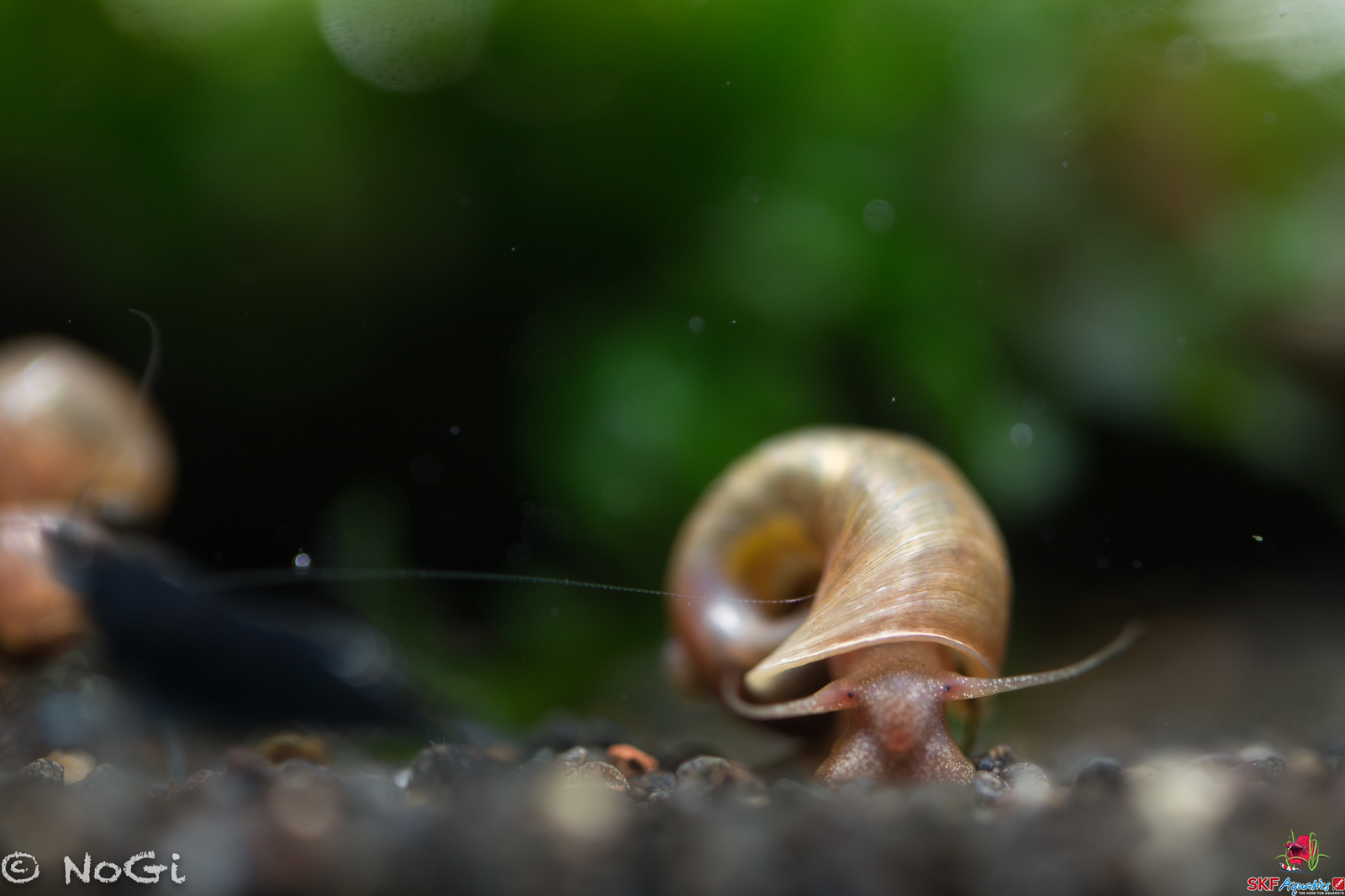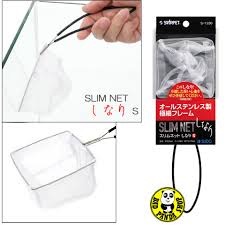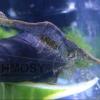Search the Community
Showing results for tags 'snails'.
-
Ooooh I am so excited about this! I received my snail package yesterday: Spiny Marsh Snails ( Thiara Amarula), Giant Cone Snails (unsure what these are ), Assorted Nerites ( not being an expert, I am unsure of exact types, but I have some with striated tan/black pattern, spots, zigzag, olive and black), and Singapore Spiraling snails that have black shells ( these are actually from China, but don't mass produce). I asked one of the online stores that I buy from whether they could get some for me and it turns out one could. They are not exactly cheap, but one has to keep in mind that they are responsibly sourced, they don't mass produce, are stunning to look at, are quite large, and whomever the person is that has to dig them out in murky crocodile infested water, with mosquitoes and 40 degrees Celsius plus weather with leeches definitely deserves to get paid by those of us with a higher sense of self-preservation in my opinion!) I am not a photographer, and had to rush to get a few pics. None of the snails are in too acidic water, seem to like algae wafers, and love digging in the substrate. The shrimp follow the snails as they borrow through the soil and forage on the upturned biofilm. If anyone would like to know where to buy them, you are welcome to pm me as I am not sure whether I am allowed to post the suppliers details on here.
-
https://drive.google.com/file/d/1vSxPM7PkOmYtP4RdBsGUkBKuVD39dgSa/view?usp=drivesdk
- 2 replies
-
- 2
-

-
- video
- seed shrimp
-
(and 1 more)
Tagged with:
-
Melanoides tuberculata, commonly known as Malaysian Trumpet Snails (MTS), originated from all over Africa and Southern Asia. MTS are generally introduced into fish tanks accidentally by being attached to new plants or used aquarium decorations. They can come in a range of shapes, patterns and sizes. Opinions on MTS are divided with most having a strong dislike to them due to how quickly they breed and take over a tank. However, these snails can also be beneficial. As they move eating detritus and leftover food under the substrate, they are also aerating it. This in turn supports root growth and air exchange which are great in planted tanks. How Do They Breed Malaysian Trumpet Snails breed extremely fast, particularly in good tank conditions. The rapid breeding abilities of the MTS is one of the main reasons they are a concern to aquatic tank keepers. One method that works well with our members here is to use some vegetables like a sliced cucumber. Turn the lights off, wait a little while and remove. You can also limit their population growth by being strict with your feeding regime and removing any uneaten food from the tank. Take note though, without the use of a chemical deterrent, which is harmful to your other invertebrates, it will be unlikely that you can remove 100% of them. What Do They Eat They are not difficult to feed. Primarily, Malaysian Trumpet Snails consume large amounts of algae and detritus. They are also good scavengers – eating leftover food and fish waste as they burrow underneath the substrate; thus, doing their share of cleaning the tank. They are especially helpful to aquarists who collect messy freshwater fish, including goldfish, and who keeps live plants. No, MTS generally do not eat live plants. You can also supplement their diet by feeding them with leafy vegetables or any plant-based fish food. Just don’t overfeed them as this will cause a snail outbreak. Water Parameters These snails are not difficult to care for as they only require minimal attention. If the tank is good enough for your fish and/or shrimp, there is a good chance that it will be fine for them. That said, if you want to get technical, they should be kept in a freshwater tank range with the following water conditions: water temperature from 21° C to 26° C pH of 7.0 to 7.5 Sources: Vogler, R. E., Núñez, V., Gregoric, D. G., Beltramino, A. A., & Peso, J. G. (2012). Melanoides tuberculata: The history of an invader. Chapter, 3, 65-85. Image credit - @Paul Minett Image credit - Nogi
-
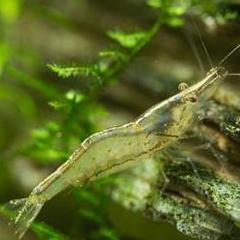
New Library Article - Melanoides tuberculata - Malaysian Trumpet Snails
NoGi posted a topic in Freshwater Snails
Melanoides tuberculata, commonly known as Malaysian Trumpet Snails (MTS), originated from all over Africa and Southern Asia. MTS are generally introduced into fish tanks accidentally by being attached to new plants or used aquarium decorations. They can come in a range of shapes, patterns and sizes. Opinions on MTS are divided with most having a strong dislike to them due to how quickly they breed and take over a tank. However, these snails can also be beneficial. As they move eating detritus and leftover food under the substrate, they are also aerating it. This in turn supports root growth and air exchange which are great in planted tanks. How Do They Breed Malaysian Trumpet Snails breed extremely fast, particularly in good tank conditions. The rapid breeding abilities of the MTS is one of the main reasons they are a concern to aquatic tank keepers. One method that works well with our members here is to use some vegetables like a sliced cucumber. Turn the lights off, wait a little while and remove. You can also limit their population growth by being strict with your feeding regime and removing any uneaten food from the tank. Take note though, without the use of a chemical deterrent, which is harmful to your other invertebrates, it will be unlikely that you can remove 100% of them. What Do They Eat They are not difficult to feed. Primarily, Malaysian Trumpet Snails consume large amounts of algae and detritus. They are also good scavengers – eating leftover food and fish waste as they burrow underneath the substrate; thus, doing their share of cleaning the tank. They are especially helpful to aquarists who collect messy freshwater fish, including goldfish, and who keeps live plants. No, MTS generally do not eat live plants. You can also supplement their diet by feeding them with leafy vegetables or any plant-based fish food. Just don’t overfeed them as this will cause a snail outbreak. Water Parameters These snails are not difficult to care for as they only require minimal attention. If the tank is good enough for your fish and/or shrimp, there is a good chance that it will be fine for them. That said, if you want to get technical, they should be kept in a freshwater tank range with the following water conditions: water temperature from 21° C to 26° C pH of 7.0 to 7.5 Sources: Vogler, R. E., Núñez, V., Gregoric, D. G., Beltramino, A. A., & Peso, J. G. (2012). Melanoides tuberculata: The history of an invader. Chapter, 3, 65-85. Image credit - @Paul Minett Image credit - Nogi View full article -
Planorbidae make up a significant portion of aquaitic pulmonate gastropods. In Australia alone, there are over 20 species group taxa that have been described. Their common name, ramshorn snails, comes from the spiral shape of their shells, which looks like a ram’s horn. Ramshorn snails come in a wide range of colours, including red, brown and black, and they can even be shimmery and translucent in colour. Because of the unique design on their shells and their colour, they can be a welcomed addition to an aquarium, offering vibrant colour and interest. However, oftentimes, these snails inadvertently appear in aquariums, hitchhiking on the live plants and/or accessories that have been transferred from one tank to another. If there is enough food available, these snails can quickly breed and take over an aquarium; but, if they are properly maintained, they can be a welcomed addition, even if their presence was not intended. These snails eat food that is leftover in the water, dead plant material and algae, and as such, they can help to maintain the health and appearance of an aquarium. Maintaining Ramshorn Snails Whether you are interested in adding ramshorn snails to your aquarium or they have taken up residence unexpectedly and you decide that you want to keep them, it’s important to understand how to properly maintain them, which fortunately, is easy to do. They do will in aquariums of various sizes. They are also very adaptable, which means that they can do well in various types of water conditions, though they prefer water that is filtered. Additionally, they do best in tanks that do not undergo sudden changes in their condition. These snails consume algae and food remnants from fish, but they prefer to eat dying and dead plant matter that is shed from live plants. They will also eat dead fish, shrimp or other snails. Things to Avoid If you are interested in maintaining Ramshorn snails in your aquarium, you should be aware that there are species of fish that will eat them. The most common predators of Ramshorn snails include bettas, loaches and dwarf puffer fish. Assassin snails will also prey on these snails. Live Plants Some people claim that Ramshorn snails destroy their live plants, while others have reported they do not cause any issues. However, in most cases, they do very little damage to live plants, but if a large amount of them are present and there are delicate plants in the aquarium, such as Water Sprite and Cabomba, they can do damage. Behaviour Ramshorn snails are peaceful and non-aggressive. They will not cause issues with fish, shrimp or other types of snails in an aquarium. They spend their time moving about the tank eating and adding interesting colour, texture and dimension to an aquarium. References Arctos. (n.d.). Retrieved May 7, 2017, from http://arctos.database.museum/name/Planorbidae Brown, D. S. (2001). Freshwater snails of the genus Gyraulus (Planorbidae) in Australia: taxa of the mainland. Molluscan Research, 21(1), 17-107. doi:10.1080/13235818.2001.10673736 Image credit - @Paul Minett
-
- 1
-

-
- planorbidae
- snails
-
(and 1 more)
Tagged with:
-
Planorbidae make up a significant portion of aquaitic pulmonate gastropods. In Australia alone, there are over 20 species group taxa that have been described. Their common name, ramshorn snails, comes from the spiral shape of their shells, which looks like a ram’s horn. Ramshorn snails come in a wide range of colours, including red, brown and black, and they can even be shimmery and translucent in colour. Because of the unique design on their shells and their colour, they can be a welcomed addition to an aquarium, offering vibrant colour and interest. However, oftentimes, these snails inadvertently appear in aquariums, hitchhiking on the live plants and/or accessories that have been transferred from one tank to another. If there is enough food available, these snails can quickly breed and take over an aquarium; but, if they are properly maintained, they can be a welcomed addition, even if their presence was not intended. These snails eat food that is leftover in the water, dead plant material and algae, and as such, they can help to maintain the health and appearance of an aquarium. Maintaining Ramshorn Snails Whether you are interested in adding ramshorn snails to your aquarium or they have taken up residence unexpectedly and you decide that you want to keep them, it’s important to understand how to properly maintain them, which fortunately, is easy to do. They do well in aquariums of various sizes. They are also very adaptable, which means that they can do well in various types of water conditions, though they prefer water that is filtered. Additionally, they do best in tanks that do not undergo sudden changes in their condition. These snails consume algae and food remnants from fish, but they prefer to eat dying and dead plant matter that is shed from live plants. They will also eat dead fish, shrimp or other snails. Things to Avoid If you are interested in maintaining Ramshorn snails in your aquarium, you should be aware that there are species of fish that will eat them. The most common predators of Ramshorn snails include bettas, loaches and dwarf puffer fish. Assassin snails will also prey on these snails. Live Plants Some people claim that Ramshorn snails destroy their live plants, while others have reported they do not cause any issues. However, in most cases, they do very little damage to live plants, but if a large amount of them are present and there are delicate plants in the aquarium, such as Water Sprite and Cabomba, they can do damage. Behaviour Ramshorn snails are peaceful and non-aggressive. They will not cause issues with fish, shrimp or other types of snails in an aquarium. They spend their time moving about the tank eating and adding interesting colour, texture and dimension to an aquarium. References Arctos. (n.d.). Retrieved May 7, 2017, from http://arctos.database.museum/name/Planorbidae Brown, D. S. (2001). Freshwater snails of the genus Gyraulus (Planorbidae) in Australia: taxa of the mainland. Molluscan Research, 21(1), 17-107. doi:10.1080/13235818.2001.10673736 Image credit - @Paul Minett View full article
-
- 2
-

-
- planorbidae
- ramshorn
-
(and 1 more)
Tagged with:
-
I bought this Sudo Slim shrimp net as I was not happy with my current netting options. Found an unexpected awesome use for it: those annoying tiny snails on the walls of your aquarium glass? Because this net is so flexible and the wire rim where the edge meets the net is so thin, it is extremely easy to just scrape all of the snails with one swoop into the net. Highly recommended. Good quality netting material. It is of such a good weave that I catch seed-shrimp with it in my smaller tank. Only drawback: short handle, but one could argue that it gives you very good control of the net. Very good at shrimp catching too as there is no escape once the net is flush against the glass. My favourite net all- round. I will rate this net ????/5 shrimp tails
-
Finally getting around to posting the rest of the field trip pics and videos. Next up is the Mulgrave River, located near to Bob's place. in fact, Bob and I walked to this location from his place. This is a shallow section where the red Valisneria occurs, with some other plants. Bob and I also found some nerites (Neritina pulligera) and the ever-present Stenomelania denisoniensis snails (grey foot colour variant). Water parameters were: pH: 7.0 - 7.1 GH: < 20 ppm KH: 10 - 20 ppm Temp: 22.5*C TDS: 29 The water in this section was around a foot to max. 1 metre. The red val Found the Stenomelania snails near the waters edge We first noticed the nerites by spotting their egg cases which were everywhere when we started looking. They were in the areas away from the plants, plenty of rocks (not sand) and a bit of timber and leaf litter. We found the nerites by turning over rocks, they were generally underneath, but occasionally not. The best way to tell where they were was to spot the white eggs (newly laid). The eggs turn yellowish with age. Also found a freshwater sponge under the rocks in this area Video of the nerites' habitat There were also a few Mulgrave gudgeons hanging out in this area We then moved downstream slightly to where the water ranged in depth from 1 metre to 2.5 metres. I apologise for the bumpy filming but I was fighting a swift current.


